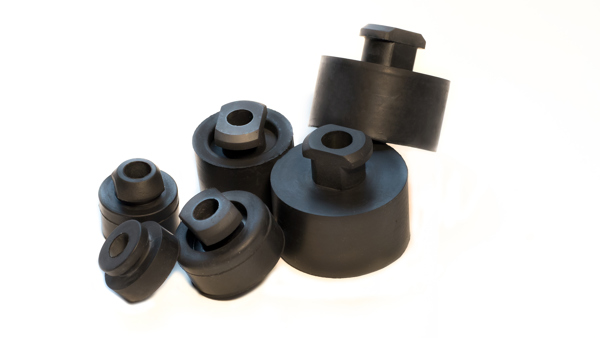
The compressor plays a critical role in air conditioning systems. Unfortunately, that same compressor is going to vibrate when it supplies air or other gasses at increased pressure. The resulting noise from this vibration is an issue for any quiet-loving consumer, so it’s important to take steps to make your A/C units as silent as possible. Fortunately, there are a couple of rubber parts that can mitigate the impact of a vibrating compressor:
Both parts are designed to accomplish the same goal: sound and vibration dampening. However, each part performs this role in very different ways and has specific needs to help ensure success. Let’s break down what you need to consider when investing in compressor grommets and dampeners for the A/C units your business manufactures.
Compressor Grommets
A good compressor grommet serves as the foundation for a quiet A/C unit. Since these parts sit at the base of a compressor, they require some fine-tuning to ensure that they can properly absorb vibration and sound created by a running unit.
Design considerations
When it comes to compressor grommets, consider these three key areas to properly isolate that sound and vibration:
• Size
• Compression set
• Tensile strength
There are numerous design iterations out there for compressor grommets, but they all share the same main elements: a base, a neck, and a head. Sure, there will be variations based on the manufacturer, but those elements will stay the same. What will drastically change is the size of the compressor grommet. The magnitude of these parts typically correlates to how big the compressor is – simply put, the bigger the compressor, the bigger the grommet.
A low compression set is another critical element. Without the proper compression set, your grommets won’t bounce back to their original shape when the compressor moves and inevitably squishes the part. Instead, the grommet will keep its new, less supportive shape. This scenario will negatively impact the performance aspects of your compressor grommets. As such, it’s crucial to identify the right compression set so that your parts properly bounce back to maintain performance.
Tensile strength is another key factor for compressor grommets. Poor tensile strength reduces the resiliency of your compressor grommets, which is a notable issue for a part that’s made to endure regular vibration. With the right tensile strength, your parts will be able to endure the ongoing rigors of quieting down compressors.
Material options
There are a couple of potential material options for compressor grommets, but EPDM is by far the most common solution. This high-density synthetic rubber is a cost-effective polymer that can take a beating and still bounce back. Neoprene is another option for the same reasons but adds some oil resistance in case that were to pose any issues. Natural rubber is another potential solution, but is typically saved for rare instances.
Sound and Vibration Dampeners
While grommets can help mitigate the vibration and noise of the compressor itself, the various refrigerant tubes require a different solution. These copper conduits will vibrate as the connected compressor pumps refrigerant through the system. However, you can’t just snap any sound and vibration dampeners over each tube to solve the situation.
What to consider
Like compressor grommets, there are three main criteria to consider for your dampeners:
- Weight/cut length
- Fit
- Part resistances
Each dampener is made to add a little weight to each refrigerant tube. This extra weight should then deaden any vibration and noise it potentially makes. However, you need to find the right weight for your dampeners. If a dampener is too heavy, it’s not only more expensive, it can also give the vibration momentum and exacerbate the issue. If a dampener is too light, it’s simply ineffective.
Of course, the weight required for each tube can vary greatly. There are different avenues by which refrigerant is routed through a unit, and each line can be a different size. Various tubes mean that you’ll need to find the sweet spot for each tube. This process can involve testing out different materials and cut lengths to identify the correct dampener for each tube size.
You’ll also need to consider how you plan to fasten your dampeners to each tube. These dampeners essentially act as a form of sleeve for tubes, but some can clip on by themselves while others may require a clamp or zip tie to stay attached. For clip-on dampeners, it’s important to make sure you have the right inner diameter and cuts to ensure a tight fit. If not, you may need a fastener of some sort to ensure your dampeners won’t fall off over time.
Dampeners also need to take certain environmental factors into consideration. These parts are typically exposed to the elements, so you’ll need a material with ample ozone, weathering, and aging resistance to maintain sound and vibration dampening for a long time.
Material options
As with compressor grommets, sound and vibration dampeners are typically made with EPDM for the same combination of deadening performance and cost-effectiveness. The exact formulation can vary greatly depending on the testing process. If more weight is required, there are ways to impregnate the rubber with fine metal to add extra heft to your dampeners without changing the look and feel of the part.
If EPDM doesn’t meet your needs, butyl rubber is another option. This material is generally harder, “dead” material that essentially absorbs everything in terms of sound and vibration. While butyl is more expensive than EPDM, it is a reliable solution for heavy-duty situations where you need to ensure deadening performance.
Identify the Perfect Compressor Grommets and Dampeners for Your HVAC Units
When noise is a big issue, it’s crucial to have the right compressor grommets and dampeners for your systems. As a premium HVAC rubber parts supplier, we have the knowledge and expertise to help you identify the right solutions for your units. We work directly with you to identify your exact needs and either provide existing part options to consider or uncover a custom design made specifically for your applications.
When you need the right rubber parts for your HVAC units, we can help. Give us a call at 800-969-6242 or contact us online to get a quote today.
